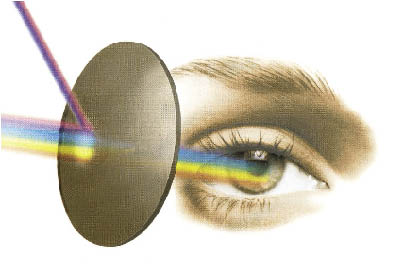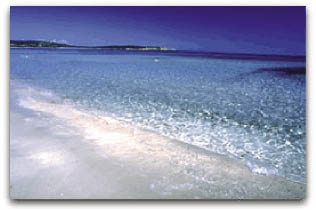SUNGLASSES:
NOT ONLY A FASHION ITEM
“It
is absolutely insufficient that glasses have dark lenses as some mistakenly
believe, and as others will lead you to
believe.”
Federico Bartolomei
Summer is here
and so is the issue of protection from sun rays.
People love sunlight,
which influences in a decisive way our activities and our state of
mind, even our hormonal level.
From being a goodwill agent to a damaging
agent: excessive exposure can cause serious damage to the skin and to
the eyes.
Natural light is composed of electromagnetic radiations of
various wavelengths, and their visible portion constitutes only a small
part.
The eye is able to perceive only electromagnetic oscillations of
wavelength between about 370 and 700 nm (visible spectrum).
Radiations take up various bands, which are characterized by specific
chromatic signals: between 380 and 430, they appear violet; between 430 and
470, blue; between 470 and 520, green; between 520 and 590, yellow;
between 590 and 610, orange; between 610 and 700, red.
Accredited
by the analysis of the sun's effect on the Rhesus Monkey's eyes,
numerous scientific studies have demonstrated that ultraviolet radiations (UV)
and visible radiations (if sufficiently intense) can be at the basis of
biological damages.
 Blue light is therefore more damaging than green light, and
green light is more damaging than red light. In short, the danger
from radiation increases with the intensification of the energy, therefore
with the decrease in wavelength.
Blue light is therefore more damaging than green light, and
green light is more damaging than red light. In short, the danger
from radiation increases with the intensification of the energy, therefore
with the decrease in wavelength.
In
function of biological effects, it is usual to separate ultraviolet
radiations into three bands: UV-A, UV-B, UV-C.
The UV-C radiation is the
most energetic one and could be quite damaging to our eyes let alone our skin,
but it is fortunately almost completely blocked by our atmosphere. In fact,
the UV-C radiation is absorbed, with a peak of around 150 nm,
from molecules of oxygen.
The ozone is the second defense for our eyes
provided by the atmosphere, since it can absorb longer UV-C radiations or part
of the UV-B spectrum, with a maximum peak of absorption of around 260
nm.
For that reason, ultraviolet radiations arriving on earth always
have wavelength superior to 280 nm.
Because of the well-known hole in
the ozone layer, that is the reduction of the layer present in the
atmosphere at heights between 15 and 35 km, it is estimated that
in the next decades we will receive an additional dose of radiations.
The
three bands of ultraviolet radiations are not absorbed in the same way from the
various ocular means, and the absorbing factor is decisive in understanding the
damages that can be caused by the radiation.
The UV-B radiation is almost completely absorbed by the
cornea (Fig. 4).
It is for that reason that the UV-B radiation can be
responsible for keratitis and conjunctivitis. The UV-A radiation, however
the less energetic of the three, is largely absorbed by the
crystalline lens (for example, 52% of the radiation at 360 nm is absorbed
by the crystalline lens).
Problems caused by the infrared radiation are less
important but it becomes dangerous only in situations where there are
high temperature sources: ovens, blast furnaces, etc.
Visible violet and blue
photons can be damaging to the retina. The link between ocular diseases and UV
and visible electromagnetic radiations was confirmed by experimental
investigations, which have drawn attention to the fact that populations who are
more exposed to the sun, like fishermen and farmers, are more prone to
suffer from the diseases mentioned above.
Everyone
should be informed about the use of lenses with UV filters, besides sunscreens,
visors and hats.
Be aware not to underestimate UV on cloudy days: the heat
from the sun is less perceptible because the clouds absorb it, but UV go through
the clouds better than visible light.
Moreover, we are today exposed to
the dangers of UV radiations coming from non-solar sources. Fluorescent
lights, lasers, soldering work, tanning lights are a few of the non-solar UV
sources with which we normally come into contact.
It is therefore
particularly recommendable to use sunglasses with lenses of optimum quality
and made according to regulations established by public organizations: that is,
lenses which absorb 100% of the UV rays and up to 96% of the violet and blue
rays.
The eye reacts to strong luminosity causing a constraint on
the iris. Because of the reduced pupillary aperture (miosis), there are
less light rays entering the eyes, which defend themselves from the
strong environmental luminosity. This a phenomenon
called dazzlement.
Classical examples of such extreme situations,
where the eye is confronted with very strong light sources, are: on a white
beach, on the snow, on the smooth asphalt in the summer, etc.
This condition
produces a loss of comfort, or even the inability to see details or objects,
leading to a true disability such as to reduce the sense of
direction.
Consumers
buying glasses must know that there exist precise public dispositions
regulating production and commercialization of sunglasses, which must by law
comply with standards of quality. Since July 1st, 1995, all sunglasses must
indicate on their labels their filtering capacity, from 0 to 4, as well as the
CE symbol. It is important at the moment of the purchase to look
for these elements.
It is absolutely insufficient that the sunglasses have very
dark lenses as some mistakenly believe. Paradoxically,
dark lenses that do not have an ultraviolet filter are even worse than fully clear lenses
because they reduce the mechanism of pupillary aperture
(miosis) contraction, which is one of the best natural defense mechanism
that the eye has. Aside from direct light, the eye needs also to be
protected from sun rays that may enter by the each side or around the
lenses. UV reflected by snow, lakes and rivers are an important sources of
indirect radiations for the eyes. Chromed and brilliant metallic surfaces
reflect up to 85% of UV, and white cotton reflects up to 50%. This means that it
is not advised to choose a frame with lenses that are too small,
not providing sufficient protection against these accidental rays of which
the level of danger is not to be underestimated.
are even worse than fully clear lenses
because they reduce the mechanism of pupillary aperture
(miosis) contraction, which is one of the best natural defense mechanism
that the eye has. Aside from direct light, the eye needs also to be
protected from sun rays that may enter by the each side or around the
lenses. UV reflected by snow, lakes and rivers are an important sources of
indirect radiations for the eyes. Chromed and brilliant metallic surfaces
reflect up to 85% of UV, and white cotton reflects up to 50%. This means that it
is not advised to choose a frame with lenses that are too small,
not providing sufficient protection against these accidental rays of which
the level of danger is not to be underestimated.
Mountain
climbers and skiers in high altitude have always used sunglasses with a
strong ultraviolet protection often with mirrored lenses, which help in reducing
the passage of sun rays (the filtering capability of a lense increases
by one fourth of a degree when it is mirrored). These glasses may also be
laterally closed by blinkers. However, these blinkers, or side-pieces that
could be too large, reduce the lateral visual field and are not
always recommendable. In a driving situation for example, they can
create awkward or even dangerous situations particularly when arriving at
crossroads. In some cases, using polarized lenses would be useful. These contain
small special crystals (dicroic) which can block a lot of the
reflected light. As for the colour of the lenses, once the exigence of
filtering visible and invisible rays has been take care of, it is a matter of
taste, however within certain limits. Yellow or orange lenses increase
contrast and are indicated in conditions of low environmental luminosity and low
contrat (fog, rain). It must be remembered that strong colours (often useful in
cases of low vision) tend to alterate chromatic perception of the environment
and consequently of light signals, etc. The standard colour
used in aviation is neutral gray, a colour that softens luminosity without
significantly altering colours in the
environment.
BIBLIOGRAPHY:
Cordella Marco, Lenti
alla melanina quando e perché prescriverle, 1999, ED. Intercast
Europe
Cristini G., Meduri R.,
Basi fisiopatologiche di Clinica Oculistica, 1983, ED UTET
Abati S., Farini A.,
Filtraggio della radiazione elettromagnetica e ipovisione, Argomenti di
ipovisione supplemento 2, 2002, Ed. Fabiano
Meduri R., Scalinci SZ,
Scorolli L., L’ipovisione, Edizione Martina, Bologna, 1995
 Blue light is therefore more damaging than green light, and
green light is more damaging than red light. In short, the danger
from radiation increases with the intensification of the energy, therefore
with the decrease in wavelength.
Blue light is therefore more damaging than green light, and
green light is more damaging than red light. In short, the danger
from radiation increases with the intensification of the energy, therefore
with the decrease in wavelength.
 are even worse than fully clear lenses
because they reduce the mechanism of pupillary aperture
(miosis) contraction, which is one of the best natural defense mechanism
that the eye has. Aside from direct light, the eye needs also to be
protected from sun rays that may enter by the each side or around the
lenses. UV reflected by snow, lakes and rivers are an important sources of
indirect radiations for the eyes. Chromed and brilliant metallic surfaces
reflect up to 85% of UV, and white cotton reflects up to 50%. This means that it
is not advised to choose a frame with lenses that are too small,
not providing sufficient protection against these accidental rays of which
the level of danger is not to be underestimated.
are even worse than fully clear lenses
because they reduce the mechanism of pupillary aperture
(miosis) contraction, which is one of the best natural defense mechanism
that the eye has. Aside from direct light, the eye needs also to be
protected from sun rays that may enter by the each side or around the
lenses. UV reflected by snow, lakes and rivers are an important sources of
indirect radiations for the eyes. Chromed and brilliant metallic surfaces
reflect up to 85% of UV, and white cotton reflects up to 50%. This means that it
is not advised to choose a frame with lenses that are too small,
not providing sufficient protection against these accidental rays of which
the level of danger is not to be underestimated.